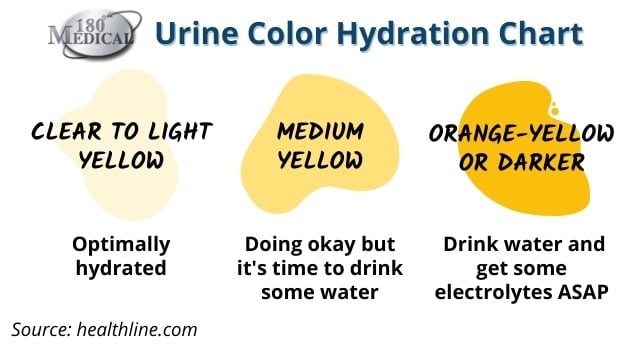
Urinary tract infections (UTIs) are one of the most common complications for people with spinal cord injuries (SCI). In fact, for the first three years after my spinal cord injury, I would get UTIs so often that I was calling my urologist in desperation all the time. One day, he was not available, but I spoke to his nurse, whose wealth of knowledge made a significant impact on my self-care regarding UTIs from that point on.
Why Are People with Spinal Cord Injuries Prone to UTIs?
First, let’s go over why those of us with spinal cord injuries deal with UTIs more frequently.
With a spinal cord injury, if we have limited to no sensation below the waist (particularly the pelvic or bladder area), this can cause complications. For example, we can’t tell if our bladder is emptying properly. Also, we can’t usually feel many of the first warning symptoms that people without SCI can feel, such as a burning sensation when urinating.
Because of that, along with the need to use intermittent catheters multiple times per day, people with spinal cord injuries very easily develop bladder infections and urinary tract infections.
Common Symptoms of Urinary Tract Infections
When you live with paralysis due to a spinal cord injury, you may not experience the typical burning sensation. However, here are a few telltale symptoms and issues to watch out for.
- New uncontrollable incontinence or increased frequency
- Strong odor in urine
- Fever
- Blood or cloudiness in the urine
- Pelvic discomfort (especially in women)
- Back pain
- Cold chills
- Nausea & vomiting
- Autonomic dysreflexia

Can a UTI Cause Autonomic Dysreflexia?
Autonomic dysreflexia is a condition that is most common in people with a spinal cord injury at the T5 (thoracic) level and above. This condition causes sudden, severely high blood pressure. This is an emergency condition that can lead to severe and potentially fatal complications if left untreated. So immediately call your doctor or 911 when you notice the symptoms of autonomic dysreflexia, such as a sudden pounding headache, flushing skin, sweating, and a slowing heart rate.
Sometimes, autonomic dysreflexia can happen due to overheating with an SCI. However, it can also happen if something is irritating your body below the level of your injury. According to WebMD, this could be due to urinary tract infections, constipation, kidney stones, or pressure sores.
Tips for Preventive Care for UTIs with Spinal Cord Injuries
1. Find a physician familiar with spinal cord injuries.
If your current physician is not familiar with the spinal cord injury and the bladder sensitivities that occur from a spinal cord injury, it is time to find one that is.
Often, if a physician is unfamiliar with spinal cord injuries or neurogenic bladders, their usual course of action when dealing with a urinary tract infection is to only prescribe antibiotics.
While this can be helpful for many people, people dealing with recurrent UTIs who also have an SCI may find the problem escalates over time. After taking a round of antibiotics, the infection may subside only to come back again. As we continue to take more antibiotics, the less effect it may have on us. Then, the only treatment that may work could mean going to a hospital to get antibiotics administered intravenously.
Therefore, antibiotics may not always be the only right solution for people dealing with UTIs with a spinal cord injury. A doctor who is familiar with the complications of spinal cord injuries may only prescribe antibiotics in the case of a fever.
For this reason, it is so important that anyone with a spinal cord injury understands their body and what they can do to help prevent getting urinary tract infections.
2. Stay hydrated and keep an eye on your urine.
As you probably already know, most people with spinal cord injuries must use a urethral catheter each time they need to urinate. However, using catheters may increase the chances of getting a UTI.
So part of your preventive care routine should include looking at your urine when you cath. Is it cloudy? Does it smell? Is it dark or light? Healthy urine will look light yellow or clear like water. However, the constant invasion of a foreign object (your catheters) may also we use a catheter frequently, it will increase our chances of having UTIs. After you have cathed, look at your urine. Is it cloudy? Does it smell? Is it dark or light in color? Healthy urine will look very light yellow or nearly as clear as water.

One way to help reduce colonized bacteria in your bladder is to drink water every day. Your doctor is the best source for how much you should drink for your body type.
Personally, I try to take in a normal daily amount of water by taking sips of water throughout the day. Also, I make sure I’m self-cathing at the prescribed intervals of the day.
3. Know your bladder limits.
Did you know that bladders only hold up to a certain amount of urine before they begin to leak? As a person with a spinal cord injury that relies on urinary catheters, you should probably know the size of your bladder.

The best way to do that is by getting a cystometrogram (CMG), which is a bladder pressure-flow study typically done by a urologist. This test measures the amount of urine the bladder can hold. It’s also an effective way for your urologist to determine how they should treat your bladder issues, such as urinary retention, urinary incontinence, overactive bladder, etc.
This test may also help your urologist determine the appropriate self-catheterization schedule for you, including the appropriate number of times per day to cath.
4. Find the best catheter supplier for your needs.
Once you know how often to self-catheterize, you’ll need to figure out what type of catheter is right for you.
I cannot emphasize enough how important it is for you to have a good catheter company who will be there to help you find the right catheter and collaborate with you and your doctor.
At 180 Medical, their insurance experts can verify your insurance plan’s catheter coverage so they know what your insurance company will help cover. Plus, they have Product Specialists on staff who can help you find a type of catheter that may help prevent the risk of infection, such as no-touch catheters or closed system catheters.
There are so many good catheter options today, coming in all types and sizes. Also, many catheters today come in discreet packaging, such as pocket catheters, making them very convenient for you to carry with you.
A good company will have specialists who know their products in and out and can guide you through the process of finding the right catheter. Plus, they’ll communicate with your urologist to get any documentation or authorizations that your insurance might require.
If you’re ready to get started, contact 180 Medical.
Disclaimer: The views and opinions expressed here are solely that of the author. It is not intended to be taken as medical advice. Please consult your physician for medical advice or in the case of an emergency.
